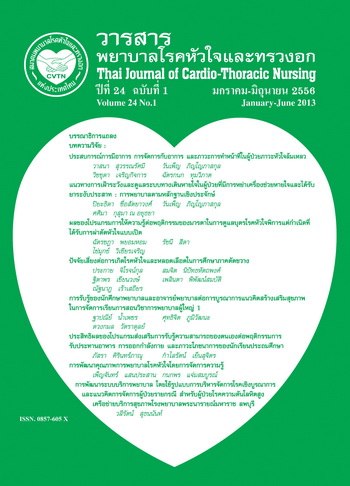ปัจจัยเสี่ยงต่อการเกิดโรคหัวใจและหลอดเลือด ในการศึกษาภาคตัดขวาง
Keywords:
การมีกิจกรรมทางร่างกาย, พฤติกรรมการบริโภคอาหาร, ความเสี่ยงต่อการเกิดโรคหัวใจและหลอดเลือด, คะแนนความเสี่ยงต่อการเกิดโรคหลอดเลือดหัวใจสำหรับคนไทย, Physical activity, Dietary behaviors, Cardiovascular Risk, Rama-EGAT heart scoreAbstract
การศึกษาภาคตัดขวางนี้มีจุดประสงค์เพื่อ ระบุปัจจัยเสี่ยงที่ไวต่อคะแนนความเสี่ยงต่อการเกิดโรคหัวใจ และหลอดเลือด กลุ่มตัวอย่างประกอบด้วยอาสาสมัครจากบุคลากรของมหาวิทยาลัยแห่งหนึ่ง จำนวน 1,081 คน เครื่องมือที่ใช้ในการวิจัยประกอบด้วย 3 ส่วน 1) แบบสอบถามการมีกิจกรรมทางกายของ IPAQ (International Physical Activity Questionnaire) แบบสั้น 2) แบบวัดพฤติกรรมการบริโภคอาหารที่เสี่ยงต่อการเกิดโรคหัวใจและหลอดเลือด 3) แบบประเมินความเสี่ยงต่อการเกิดโรคหลอดเลือดหัวใจสำหรับคนไทย (Rama-EGAT heart score) และผลการตรวจเลือด ได้แก่ ระดับโคเลสเตอรอล ไตรกลีเซอไรด์ ไขมันเอชดีแอล และไขมันแอลดีแอล การวิเคราะห์ข้อมูลใช้สถิติ Pearson’s Product Moment Correlations เพื่อทดสอบความสัมพันธ์ของตัวแปรที่ศึกษา
ผลการศึกษาพบว่าค่าดัชนีมวลกาย ค่าอัตราส่วนเส้นรอบเอวต่อสะโพก ระดับโคเลสเตอรอล ไตรกลีเซอไรด์ และไขมันแอลดีแอล มีความสัมพันธ์ในทางบวกกับคะแนนความเสี่ยงต่อการเกิดโรคหัวใจและหลอดเลือด อย่างมีนัยสำคัญทางสถิติ (p <0.01) ส่วนระดับไขมันเอชดีแอลมีความสัมพันธ์ในทางลบ ซึ่งเป็นไปตามสมมติฐาน นอกจากนั้นพบว่าพฤติกรรมการบริโภคอาหารที่เสี่ยงต่อการเกิดโรคหัวใจและหลอดเลือด มีความสัมพันธ์ในเชิง ลบอย่างมีนัยสำคัญทางสถิติกับคะแนนความเสี่ยงต่อการเกิดโรคหัวใจและหลอดเลือด และ การมีกิจกรรมทางกาย มีความสัมพันธ์ในเชิงบวกกับคะแนนความเสี่ยงต่อการเกิดโรคหัวใจและหลอดเลือดอย่างมีนัยสำคัญทางสถิติ (p<0.05)
ผลจากการศึกษานี้สามารถนำไปใช้ในการเลือกตัวแปรที่เหมาะสมสำหรับการติดตามการปรับเปลี่ยนพฤติกรรมและพัฒนาโปรแกรมการการสร้างเสริมสุขภาพเพื่อให้เกิดพฤติกรรมสุขภาพที่ดี
Cardiovascular risk factors in a cross-sectional study
This cross-sectional study was aimed to identify risk factors, which were sensitive to cardiovascular risk scores. Data was collected voluntarily from the sample of 1,081 university personnel using three sets of measures: 1) International Physical Activity Questionnaire (IPAQ)-Short form, 2) Cardiovascular riskily dietary behaviors questionnaire , 3) A screening test for the early detection of coronary heart disease (Rama-EGAT heart score) including results of blood chemistry for cholesterol, triglyceride, LDL-C, and HDL-C levels. The Pearson’s Product Moment Correlations were used to test the correlation among variables.
It was found that BMI, waist to hip ratio, level of cholesterol, triglyceride and LDL-C were positively and significantly correlated with cardiovascular risk scores while HDL-C had a negative correlation with cardiovascular risk scores (p< 0.01) which were according to the research hypotheses. The analyses revealed a statistically significant negative relationship between cardiovascular riskily dietary behaviors and cardiovascular risk scores and a positive relationship between physical activity and cardiovascular risk scores (p<0.05).
The results provide information on suitable variables that could be used for monitoring and establishing a health promotion program to improve healthy behavior.
Downloads
Published
How to Cite
Issue
Section
License
บทความนี้ยังไม่เคยตีพิมพ์หรืออยู่ในระหว่างส่งไปตีพิมพ์ในวารสารอื่น ๆ มาก่อน และกองบรรณาธิการขอสงวนสิทธิ์ในการตรวจทาน และแก้ไขต้นฉบับตามเกณฑ์ของวารสาร ในกรณีที่เรื่องของท่านได้ได้รับการตีพิมพ์ในวารสารฉบับนี้ถือว่าเป็น ลิขสิทธิ์ของวารสารพยาบาลโรคหัวใจและทรวงอก






